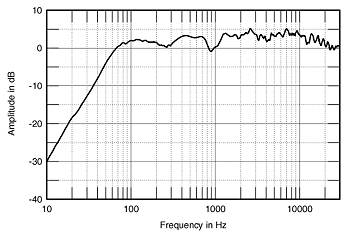Revel Home Theater Measurements Page 2

Fig.3 Revel Voice, electrical impedance (solid) and phase (dashed) (2 ohms/vertical div.).
The frequency response of the Voice is shown in Fig.4, measured and combined in the same fashion as the Gem response in Fig.2. As with the Gem, the Voice exhibits a very smooth response, with good extension up to the highest frequencies, and no significant peaks. The Gem and Voice are well-matched spectrally, though the Gem does appear to be a little more linear in the upper midrange, the Voice a little smoother in the treble. (The latter is surprising, since both loudspeakers share the same tweeter design.) I also feel that the Voice could profit from a "-2dB" setting on its tweeter-level control, a choice the Gem provides but the Voice does not.

Fig.4 Revel Voice, anechoic response on tweeter axis at 50", averaged across 30° horizontal window and corrected for microphone response, with complex sum of nearfield woofer and port responses plotted below 300Hz.
The lateral dispersion of the Voice is extremely smooth—easily as good as the Gem, perhaps even a little better. Off-axis seating positions should be no problem with the Voice. Vertical dispersion likewise will not be a problem if you sit reasonably close to the tweeter's vertical axis.
The impulse and step responses of the Voice are good, and very similar to those of the Gem. Like the Gem, the Voice is not time-coherent. The Voice's boundary control has only a small effect when switched between stand and (television) monitor placement, the latter dropping its response about 1dB in the 200Hz - 800Hz region. Though arguably slightly less clean than that of the Gem, the Voice's delayed resonance plot is still excellent, with no obvious aberrations that might cause audible coloration.
The cabinets of both the Gem and the Voice are reasonably well-damped. There is, however, one significant resonance in each. This falls between 600Hz and 700Hz, and is most prominent in the top panel of the Gem and the side panel in the Voice. It is likely too high in frequency and Q (responding to only a very narrow band of frequencies) to be easily excited. It certainly caused no audible problems.
This first-rate set of measurements clearly establishes that the Gem and Voice are both very well-engineered loudspeakers. I am always troubled when a loudspeaker measures bad but sounds good, or the reverse, but the Revels generate no concern on either count.
—TJN
- Log in or register to post comments




































































